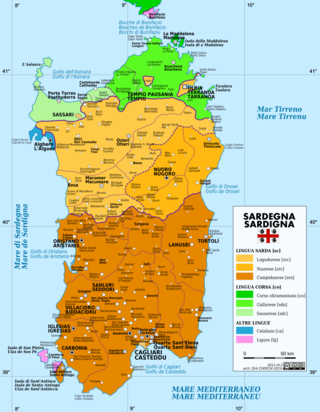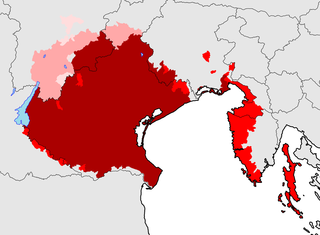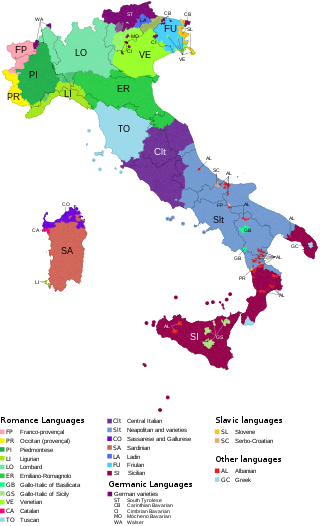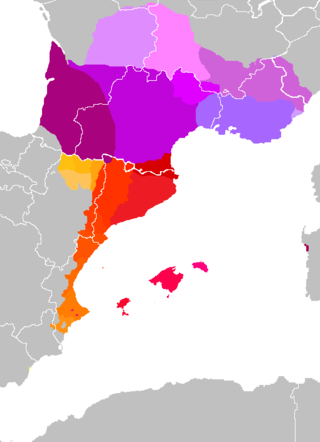Dialect refers to two distinctly different types of linguistic relationships.

Gallurese is a Romance dialect of the Italo-Dalmatian family spoken in the region of Gallura, northeastern Sardinia. Gallurese is variously described as a distinct southern dialect of Corsican or transitional language of the dialect continuum between Corsican and Sardinian. "Gallurese International Day" takes place each year in Palau (Sardinia) with the participation of orators from other areas, including Corsica.

The Romance languages, also known as the Latin or Neo-Latin languages, are the languages that are directly descended from Vulgar Latin. They are the only extant subgroup of the Italic branch of the Indo-European language family.
The Iberian Romance, Ibero-Romance or sometimes Iberian languages are a group of Romance languages that developed on the Iberian Peninsula, an area consisting primarily of Spain, Portugal, Gibraltar, Andorra and southern France. They are today more commonly separated into West Iberian and Occitano-Romance language groups.

The Gallo-Romance branch of the Romance languages includes in the narrowest sense the langues d'oïl and Franco-Provençal. However, other definitions are far broader and variously encompass the Occitan or Occitano-Romance, Gallo-Italic or Rhaeto-Romance languages.
The Istriot language is a Romance language of the Italo-Dalmatian branch spoken by about 400 people in the southwestern part of the Istrian peninsula in Croatia, particularly in Rovinj and Vodnjan. It should not be confused with the Istrian dialect of the Venetian language or the more distantly related Istro-Romanian, a variety of Eastern Romance.

Rhaeto-Romance, Rheto-Romance, or Rhaetian, is a purported subfamily of the Romance languages that is spoken in south-eastern Switzerland and north-eastern Italy. The name "Rhaeto-Romance" refers to the former Roman province of Raetia. The question of whether these languages actually form a subfamily is called the Questione Ladina. The Italian linguist Graziadio Ascoli, writing in 1873, found them to share a number of intricacies and believed they formed a linguistic group. The Rhaeto-Romance languages differ from Italian in their evolution from Latin by having passed through a stage with phonemic vowel length, undergone certain consonant developments, and possibly developed a pair of central rounded vowels. If the subfamily is genuine, three languages would belong to it: Romansh in Switzerland, and Ladin and Friulian in Italy. Their combined number of speakers is about 660,000; the large majority of these speak Friulian.

Venetian, wider Venetian or Venetan is a Romance language spoken natively in the northeast of Italy, mostly in Veneto, where most of the five million inhabitants can understand it. It is sometimes spoken and often well understood outside Veneto: in Trentino, Friuli, the Julian March, Istria, and some towns of Slovenia, Dalmatia (Croatia) and Bay of Kotor (Montenegro) by a surviving autochthonous Venetian population, and in Argentina, Australia, Brazil, Canada, Mexico, the United States and the United Kingdom by Venetians in the diaspora.
A regional language is a language spoken in a region of a sovereign state, whether it be a small area, a federated state or province or some wider area.
Regional Italian is any regional variety of the Italian language.

The languages of Italy include Italian, which serves as the country's national language, in its standard and regional forms, as well as numerous local and regional languages, most of which, like Italian, belong to the broader Romance group. The majority of languages often labeled as regional are distributed in a continuum across the regions' administrative boundaries, with speakers from one locale within a single region being typically aware of the features distinguishing their own variety from one of the other places nearby.

The Gallo-Italic, Gallo-Italian, Gallo-Cisalpine or simply Cisalpine languages constitute the majority of the Romance languages of northern Italy: Piedmontese, Lombard, Emilian, Ligurian, and Romagnol. In central Italy they are spoken in the northern Marches ; in southern Italy in some language islands in Basilicata and Sicily.

Central Italy is one of the five official statistical regions of Italy used by the National Institute of Statistics (ISTAT), a first-level NUTS region, and a European Parliament constituency.
There have been many languages spoken in the Iberian Peninsula.

The internal classification of the Romance languages is a complex and sometimes controversial topic which may not have one single answer. Several classifications have been proposed, based on different criteria.

The Occitano-Romance or Gallo-Narbonnese, or rarely East Iberian, is a branch of the Romance language group that encompasses the Catalan/Valencian and Occitan languages spoken in parts of southern France and northeastern Spain.

Western Romance languages are one of the two subdivisions of a proposed subdivision of the Romance languages based on the La Spezia–Rimini Line. They include the Gallo-Romance and Iberian Romance branches. Gallo-Italic may also be included. The subdivision is based mainly on the use of the "s" for pluralization, the weakening of some consonants and the pronunciation of “Soft C” as /t͡s/ rather than /t͡ʃ/ as in Italian and Romanian.
The Italo-Dalmatian languages, or Central Romance languages, are a group of Romance languages spoken in Italy, Corsica (France), and formerly in Dalmatia (Croatia).
The various regional and minority languages in Europe encompass four categories:












